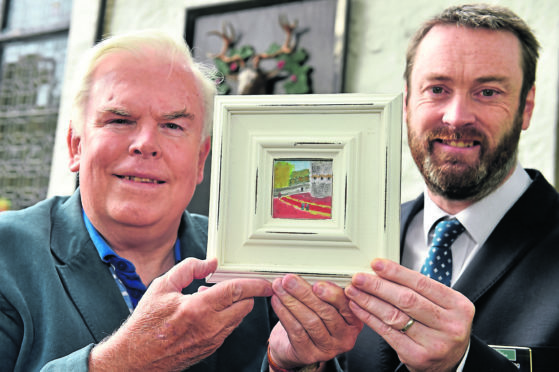An Aberdeen University law graduate is investigating the possibility that members of his family fought on both sides in the Great War.
Iain Leighton, 66, whose great uncle Charles, from Banchory, was among the many north-east troops killed during the conflict, recently handed over a watercolour artwork to the Gordon Highlanders Museum in the Granite City.
>> Keep up to date with the latest news with The P&J newsletter
But he told the Press and Journal yesterday his research into his forebears had unearthed details about his family’s connections both to the Allied and German cause.
Mr Leighton said: “My late father’s Scottish family were from Banchory and my ancestors moved there in the mid 1500’s, when their surname was Lichton.
“In 1525 or thereabouts, one of my relatives Agnes Lichton married Burnett of Leys and the couple built Crathes Castle, east of Banchory.
“Agnes married well and many cousins travelled north to be near Crathes in the hope that with her influence, family members would be granted farm tenancies on favourable terms.
“This is why my forebears in Banchory were all involved with farming and cattle dealing until the 1950s.
“However, my great uncle Sergeant Charles Leighton who died at Mametz on July 1, 1916, did not follow the family tradition and opted to learn the trade of gardener.
“He signed up to the Gordon Highlanders when he was 19 because it was exciting for him and offered him a career.
“Two brothers went to Canada and another brother – my grandfather – went to Elgin, where initially he became a tailor before purchasing a hairdressing business.”
However, while these relatives were associated with the Allied side, Mr Leighton’s mother descended from a group known as “Baltic Germans”.
He added: “My maternal great grandfather Adolf Helvig was born in a village in 1884, in what is now north Poland.
“It seems that he had several siblings and, aged 17 or so, moved to Jelvaga near Riga for work reasons.
“There was a significant Baltic German community there. Adolf married an Amalie Gross and they decided to move to Vladivostok in eastern Russia in circa 1905.
“A mini revolution had already taken place and there had been civil disturbances, so Adolf and Amalie thought it best to move east to bring up a family.
“Their daughter, my grandmother Renate Helvig, was born in Vladivostok in October 1907.
“I am currently investigating my great grandfather’s brothers and their roles in the German army from 1914-18 and I am hoping a German friend can put me in touch with the right people, so I can discover more about them.
“These younger brothers of Adolf were born in 1886 and 1890, so they would have been 28 and 24 respectively when the war started.
“That means there is a possibility these brothers were at Mametz in July, 1916 when my great uncle Charles Leighton was killed by German machine gun fire.
“Until I get the full facts, I cannot rule it out. I am very keen to find out more about what happened to all of them.”
Bryan Snelling, chief executive of the Gordon Highlanders Museum, said the story was a reminder of how the Great War had impacted on so many families in different ways.
He added: “It is always poignant when these things come to our attention.
“These personal accounts bring home the humanity and the scale of the sacrifice which was evident throughout the Great War.”
